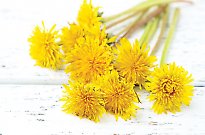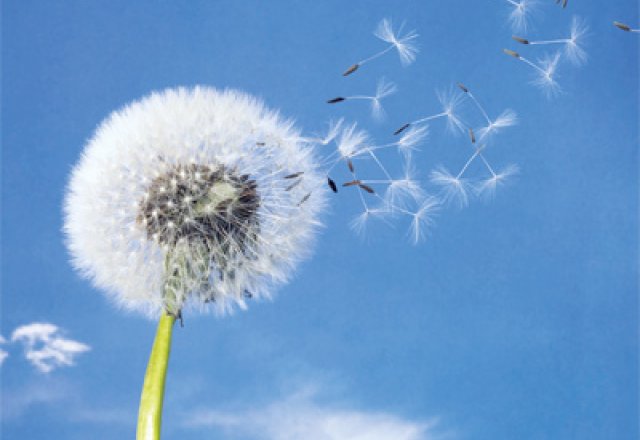
Health benefits of dandelion

More than just a weed!
Although it is little used in Western medicine, the dandelion plant (Taraxacum officinale) is rich in vitamins, is believed to be nature’s richest green vegetable source of beta-carotene and is packed with iron, calcium, phosphorous, magnesium and sodium.
With powerful diuretic and liver-cleansing properties (as well as a great source of ‘wishful’ fun for children), this universal herb has been a staple of traditional herbal medicine for centuries.
With its name originating from the French ‘dent de lion’ (teeth of the lion), referring to the jagged edges of the dandelion leaf, this plant has its roots firmly planted in the history annals of herbs used for medicinal purposes. The ancient Egyptians, Greeks and Romans knew of the plant’s benefits, the early Arabian physicians of the 10th and 11th centuries used the plant in their healing, as did the Welsh during the 13th century. Native Americans are said to have incorporated it into their diets by boiling the leaves to treat kidney disease and skin disorders and it has been consumed as a drink since the Middle Ages in the British Isles, while in traditional Chinese medicine (where it is one of the six top medicinal herbs), it has been beneficial in treating stomach problems, appendicitis and to assist in digestion.
In Ayurvedic medicine, the dandelion has long been used to treat a wide variety of urinary and liver ailments. Today, herbalists recognise dandelion as not only one of the best treatments for the liver that nature can provide, but is especially unique, as it can be used as both a medicinal herb and also incorporated into our diets.
For Sydney holistic health professional, Colleen Harvey, dandelion is the foundation of all her prescriptions. “Usually, when we prescribe herbs, we would ensure that the liver is supported, as it is a primary organ for health and plays a major role in detoxification of the body,” says Harvey, who specialises in nutrition and herbal medicine. “The liver plays a major role in digestion and as this is a major foundation of health, it’s an important one. Dandelion is a herb that is renowned for good liver health, so we always place a liver herb into a herbal formulation and classically, the major herb that is used is dandelion.”
OUR AMAZING LIVERS
To understand how dandelion works, we have to understand how our multi-functioning livers (a most underrated organ) operate. Not only does it remove poisons and toxins (like alcohol) from our bodies, but it regulates clotting, produces cholesterol and manufactures bile, which in turn assists our bodies in ridding waste products and breaks down fats during digestion.
“The liver is an amazing organ,” says Perth natural therapist Adele Plumridge, who is passionate about the benefits of herbs. “But if the liver isn’t working properly, you’re going to see problems elsewhere. If one thing is upset, it’s going to upset the balance of something else. Dandelion is one of those herbs that help the liver better cope by breaking down toxins. The liver supports the kidneys and as dandelion works as a mild diuretic, it helps act as a purative, and it also works beautifully with a combination of other herbs, like nettle for example, for skin complaints like psoriasis or eczema.”
DANDELION LEAVES
Hailing from the sunflower family and with more vitamin A content than that of carrots, this perennial plant is vastly underappreciated. The dandelion leaves are a powerhouse of nutrition, containing beta-carotenes and vitamin B, essential for energy production and the making of red blood cells. Dandelion flowers are also packed with lecithin, a powerful nutrient that assists in various liver ailments and the plant itself contains almost as much iron as spinach, while also a source of calcium, phosphorus, magnesium, sodium, and vitamin C, making it one of the best herbs we can ingest for our health. Used in salads for an interesting twist, the leaves, with their slightly bitter taste similar to chicory or endive, work to cleanse the body and allow those all-important digestive juices to flow.
“Anything we consume that is bitter starts secreting digestive juices from the mouth,” says Plumridge. “This stimulates salivary enzymes that break down our food, especially carbohydrates and sugars.”
Of course, the benefits of dandelion tea has been known for centuries and the combination of dandelion and burdoch in mead, made during the Middle Ages of Britain, has seen the drink evolve to various forms in cordial, wine, a carbonated soda and even beer.
DANDELION ROOTS
Who would have thought this plant, ubiquitous in so many areas, would have so many uses? The roots of the dandelion have long been used in tonics and liver cures to treat skin conditions and given that it stimulates bile production and assists in ridding toxins out of the body, also makes it an excellent natural booster to our immune system.
“The root is more efficient in stimulating the liver,” explains Harvey. “When you increase bile flow from the gall bladder, it can help the body break down fats more efficiently and dandelion is excellent for that. In fact, in the doctrine of signatures – the time-honoured shared philosophy of herbalists distinguished by the dandelion’s yellow flowers – usually relates to the liver and assisting the lymphatic system.”
Long used as a coffee substitute (that won’t keep you awake), the root of the dandelion is slowly making its way into our cafes. The root can also be used to make tea, believed to be effective in reducing cholesterol and uric acid levels and, as it contains high levels of inulin, a natural sugar (unlike processed or refined sugars that interfere with insulin production), the dandelion is believed to be effective for those with late-onset diabetes. The root contains anti-viral properties, works as a mild laxative and is said to help arthritis sufferers in its ability to decrease inflammation. The sap of both the root and dandelion stem is also said to work wonders in removing warts.


